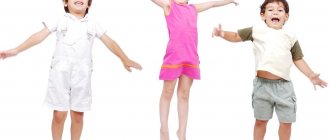Article:
A fight is a serious act that is not done out of boredom. And before you scold a child, you need to find out the motive. A fight is a serious act that is not done out of boredom. And before you scold a child, you need to find out the motive. Who was the instigator? Why did this happen? All the details are important. Moreover, you should not rely only on the words of the child and classmates; children at this age have already learned to lie well, and bullying is very common in educational institutions. Maybe your child has become an outcast in the team? Or vice versa - does he bully his classmates? The words of the class teacher, who is always aware of the situation in the classroom, are important. In addition, teachers are well acquainted with psychology and can explain what caused this or that action.
WHY DO CHILDREN FIGHT AT SCHOOL?
You can’t put everyone under the same brush, but there are 6 most common reasons for fights at school: 1. The child has become an outcast This happens if your child tries to be different from everyone else, to stand out in some way. This is not bad, but in a group it is better to express your views with restraint; at a young age, any words can be perceived incorrectly. This also happens if the child himself does not want to become part of the team, separates himself from the crowd, always sits alone and does not communicate with anyone. It’s adults who can say “introvert” or “social phobia,” but children don’t care about these terms, for them it’s just “not like everyone else,” and therefore bad. 2. The child does not know that fighting is bad. Surprisingly, this also happens. Most often, this reason is found in families where the child was carried in arms before school and spoon-fed, everything was allowed, and discipline was not taught. Of course, how does a child know that it is forbidden to fight if everything was possible for him from birth? Also, the reason may be the popular fatherly phrase: “Be a man!” Any encouragement to use force establishes in the mind that this is what needs to be done. But strength does not lie in waving your fists, but in being able to resolve issues seriously and calmly. 3. The child has experienced serious stress. Not all children know how to manage emotions, so a strong shock can cause such a reaction. Serious stress includes: the death of someone close or the death of an animal, parental divorce, etc. If you don’t start fighting this problem from childhood, it will spread into adulthood, then not only classmates, but also loved ones will suffer. 4. Fighting in a child’s family is the norm. If in a family the father beats the mother, or, even worse, the child, then it is not surprising that the child projects his anger onto his classmates. Then the child understands that fighting really helps to “let off steam”, and he begins to do it more and more often. 5. The child came under the influence of others. Children fight at school because it is fashionable and cool. This trend is especially popular in high school. The child finds himself in a bad company that has not shared something with the other, and together they go to the so-called “slaughter.” And if you don’t want to go, that means you’re no longer their friend, and you’re a coward. Who wants to earn such a reputation? Nobody. That's why most people start fighting. 6. The child tries to assert himself If he considers himself not smart enough, or if he likes a girl who does not pay attention to him, then the child will try to prove his superiority by force.
Of course, you won’t attract anyone with this, but a child’s mind has a different idea. The reason may also be that parents are overly busy and not interested in the child’s life. The child will try to attract his attention by any means, and fights are no exception.
How does fighting threaten a student?
If the student is under 14 years old, then his parents will be responsible. In this case, parents bear only financial responsibility, that is, they can pay a fine.
Serious bodily harm includes danger to life, loss of hearing or vision, termination of pregnancy, and facial disfigurement. This is already a crime.
From the age of 14, a child bears both administrative and criminal liability. He may be charged a fine or deductions if he has his own source of income. A criminal case could be brought against him for causing harm to health of moderate severity, serious bodily injury and murder. Experts assess the severity of physical damage. As a rule, if harm from beating is moderate, the victim must spend at least three weeks in the hospital. Serious bodily harm includes danger to life, loss of hearing or vision, termination of pregnancy, and facial disfigurement. When a child turns 16, he may be criminally liable for disorderly conduct and battery. An aggravating circumstance for a student would be fighting while under the influence of alcohol or drugs and intentional actions.
The instigator faces penalties from the school administration for the first time. If the penalty is repeated, the case will be brought up for discussion by the parent committee and student representatives. The school may expel a student over 15 years of age for repeated violations of discipline and law and order with the consent of these representative bodies.
HOW TO TRAIN A CHILD TO FIGHT?
It all depends on the problem, but one thing can definitely be said: no need to scold! A child will never share his life and problems if you reprimand him with or without reason. You need to calmly explain your position and listen to the child’s opinion. If the fighting does not stop, you should consult a psychologist. • If a child is a victim of bullying, it is easier to transfer him to another school. Because if you end up in a group of outcasts, it will be very difficult to get out of there. But before transferring, you need to figure out what the reason is. Because if the problem is with the child, and not with the team, then you need to solve the problem with him, otherwise the situation will repeat itself. • If a child does not know that fighting is bad, then it’s time to explain to him and gradually introduce the concept of discipline into his life. The main thing is not to do it abruptly, so that the baby does not think that he is not loved. • If a child has recently experienced serious stress, then you just need to help him cope with this period. Give him positive emotions, show him that life doesn’t end there. If possible, do not leave him alone, spend more time outside the house. This is not a matter of five minutes, but in such situations there is no other way out. • If fighting is the norm in your family, then there is no point in scolding your child. It is necessary to solve the problem in the family, perhaps get a divorce (if the husband is the rapist). And if one of the parents (or both) allows themselves to beat a child, then this must be stopped urgently, because violence will not make the child smarter, more decent and happier. He will only become embittered with you, and this will remind him of himself in the future. • If a child constantly fights at school because he has fallen under the influence of others, then you need to carefully remove him from this company. The main thing is not to insult his friends and not forbid him to communicate with them, because such a move could turn your child away from you forever. It’s worth casually bringing up arguments that will help the child understand for himself that these are not friends, but enemies. Perhaps some of your life stories will prompt him to this idea. • If a child tries to assert himself through fighting, then you need to let him know that you love him even without any achievements. Pay more attention to his positive qualities. He will soon understand that there is no need to assert himself. You can try to enroll your child in the martial arts section, maybe there he will achieve success and will “let off steam” in the gym, and not with his classmates. It is important to explain to the child that in adolescence he will already be responsible for his actions. One mistake can leave a mark for life. Therefore, you need to be careful, both with words and actions.
Home peace training
- If there is no opportunity to visit a child psychologist, then parents may find the following practical tips useful that can reduce or completely “nullify” aggressive outbursts. So what should parents do if their child is fighting?
- Learn to express anger appropriately. Show your child what to do if he is angry. Tearing paper, using a balloon as a punching bag, kicking a pillow - all this will allow you to “let off steam” without causing harm to others.
- Together, act out scenes from everyday life using figurines, repeating conflict situations that are well known to the child. Let the characters, controlled by dad or mom, show the correct ways to solve them. It’s great if this happens in a fun, relaxed atmosphere, such lessons are better learned.
- Play more with sand and water. These activities are a natural anti-stress. They perfectly relieve tension, promote general relaxation and improve mood. Especially if you spend them accompanied by calm music. There is no need for a special plot; the material itself will suggest it.
- Try to show your child as many positive examples of “bloodless” resolution of quarrels as possible. To do this, you should select special books and cartoons with simple instructive stories. They will help you clearly explain the rules of behavior and the possibilities of getting out of any difficult situations.
- If you are faced with the fact that your child is fighting with other children, then do not panic and despair. Every parent encounters this problem, sooner or later. The main thing is to cope with it successfully. We hope that the article will tell you the right ways to solve this pedagogical problem.
Students at any age can enter into conflicts - some of them end in a fight. We'll figure out what a teacher should do if schoolchildren get into a fight during class or recess, who is responsible for the fight outside of school, and how parents can help.
Aggressive behavior
Nowadays, we often talk about school bullying, applying this term to almost every situation where one child offended another. But bullying is a rather narrow concept that does not cover all types of aggressive behavior, so now we will talk specifically about childhood aggression.
You can read more about bullying here:
A child is bullied at school: what to do?
First of all, let me note: aggression is not an emotion, but a form of behavior that contains threats or causes harm. This means that it does not exist on its own and can be caused by completely different reasons, which we will talk about a little later. Aggression can be physical or verbal. Physical aggression includes slaps, kicks, damage to school supplies or clothing, and verbal aggression includes insults, threats, teasing, and so on.
In addition, there is direct aggression, when one child openly insults or hits another, and indirect, in which damage is done on the sly. For example, waiting until a classmate leaves the classroom and throwing his backpack in the trash can is indirect aggression.
In these examples, the abuser is active, either physical or verbal, openly or covertly. But aggression can also be passive and expressed, for example, in deliberately ignoring a classmate.
Finally, aggression can be reactive, that is, arising in response to the actions of other children, or spontaneous, arising due to internal reasons that others are not even aware of. Often the child himself is not aware of these reasons. Let's figure out what influences the formation of children's aggressiveness.
The reasons for bullying are always in the team
Labels dating back to elementary school are just one risk factor for gang bullying. In addition to this, there can be a great many factors. Dresses unfashionably. Does not fall into the flow of common interests. Has some strange behavior. He often gets offended and cries. And so on.
Does this mean that the target of bullying is to blame himself? Why did he turn the team against himself? And instead of being offended and complaining, he should change himself?
Perhaps something should change. I will not deny that often the “victim” behavior model is destructive and provocative. But, no matter how convenient it is for us to believe that the cause of bullying is the wrong behavior of the “victim” - this is not so. The reason is always in the team. In the level of tolerance and goodwill or, conversely, aggression and intolerance of this group of children.
Therefore, I am sure that first of all it is necessary to suppress the negative tendencies of the team in which bullying takes place. And only then - deal with those qualities of the outcast child that “caused fire upon themselves.” We all have the right to be different. And no features of a child’s appearance or behavior can justify psychological violence against him.
However, the problem of “victim behavior” exists. How to behave in order not to become an object of bullying - I also tell teenagers about this.
Eliminate recess—or keep kids occupied
When I first started working at school, my first desire was... to eliminate recess. And if not removed, then shortened - especially the long ones, twenty minutes long. During which emergencies of large and small scale occur. From lost things to traumatic fights.
Why? I think... out of boredom. And from a lack of organizing control. If during the lesson the students’ activities are clearly structured by the teacher, then during breaks they sometimes simply do not know what to do with themselves. Or maybe, to make it less boring, hide Mashin’s briefcase in the school toilet? And then watch with laughter how “cool” it will be for her to run around the school in tears?
It's easier with younger students. In good weather, children can be taken out to the school yard and organized outdoor games; in bad weather, they can give out dominoes or “riddles”, and the most restless ones can be allowed to “run around a little” in the corridor in front of the teacher. It is impossible to organize supervision for teenagers, and they do not want it.
Although it varies. For example, my daughter and her classmates enjoy spending recess in the class teacher’s utility room, drinking tea and talking. There are no conflicts or negative tendencies in the class. Or rather, there are difficult situations, but “the master’s work is afraid.” In general, relationships in the class are positive, and this is definitely the merit of the teacher.
However, there are not so many enthusiasts who organize tea parties for children during breaks. Not surprising - after all, teachers need to gain strength before the next lesson.
As a result, children who often have nothing in common other than a common number and letter of the class, children from different social strata who have completely different interests and values, children who have poor communication skills, but by any means strive to take a place in the sun in the class team - children are left to their own devices.
And the call “in case of conflict, seek help from adults” only causes an incredulous grin: where can we look for them, these adults?
How do student fights threaten the teacher?
If the teacher was in the class, he most likely saw the emerging conflict between minors and could prevent it. Therefore, he faces penalties from the administration, and the director faces a fine. But if the teacher and director prove that they are not guilty, then nothing will happen. Evidence will be required when students or parents report the fight to the police.
It is difficult to hold teachers and principals accountable for fighting among minors outside of school. If the student was registered internally at school or registered with the KDN, then a dialogue will take place between the administration and the KDN. How it goes depends on all the circumstances and the behavior of the student, it can be very different.
Fight in class: what to do?
What to do. It’s rare, but schoolchildren and schoolgirls can fight right in class or during a break in the presence of a teacher. The teacher must separate the fighters without harming any of them. It is best to separate them in different directions. It's even better if no other students are involved. When the teacher realizes that his strength is not enough, he needs to send any student to the nearest office for help.
Where to report. The director of the educational institution or his deputies.
They decide whether to report to the police or an ambulance. Usually, if there are no signs of beatings and everyone feels fine, then the police are not reported. But when a fight between specific students does not occur for the first time, then it is worth calling the police, regardless of the severity of the injuries and the nature of the harm. It is important to understand that a paramedic does not have the right to film beatings, only emergency doctors.
Be sure to inform your parents and call them to school. Here the teacher’s task is to prevent conflict between the students’ concerned parents. It is also worth informing the psychologist and the person responsible for the school reconciliation service. They must launch the process of reconciliation between the parties to the conflict.
If there is a need, you need to notify the juvenile affairs commission. As a rule, the teacher can assess the motives of the fighters and determine the culprit. If first-graders did not share the apple, could not contain their emotions and fought (but did not cause harm), the intervention of a school psychologist is sufficient. It is not necessary to register children within the school, much less notify the Control Department. But when the reason for the fight is serious or the “crime” has not occurred for the first time, it is important to notify the KDN.
How to prevent. Initially, it’s easy to understand how children live. When a teacher devotes time to students, he has a greater chance of seeing emerging conflicts: detecting an approaching quarrel or beginning bullying. Of course, moralizing conversations are unlikely to help, but training will help. They can be conducted by a psychologist or taught simple techniques by a teacher. At the trainings, children will be able to learn how to work with anger, get out of conflict without a fight, ignore the offender, and experience emotions safely.
Fight on school grounds: what to do?
What to do. If students are fighting during recess, the teacher on duty or the administrator on duty should notice this. His task is to immediately separate the fighting and prevent more children from getting involved in the fight. If the teacher was informed about a school fight by other students, he must immediately come to the scene and separate the fighters (only carefully so that he himself is not harmed by accident).
If everything happens on the porch, in the courtyard or in the school foyer, a security guard must intervene. Strangers cannot be detained, but the police must be called.
Where to report. Notify the school administration and parents. If necessary, call an ambulance and notify the juvenile affairs commission. If the conflict did not lead to serious consequences or cause harm to health, then it is enough to notify the psychologist and the person responsible for the school reconciliation service. If there are serious consequences or someone other than students is involved in the conflict, call the police.
How to prevent. The main way is to create a favorable atmosphere at school. In many ways, this is the work of the reconciliation service of an educational institution: their functionality is to extinguish emerging conflicts and create a favorable atmosphere. However, without the help of a teacher, it is unlikely that anything will come of it: he spends more time with children, his model of behavior is primarily read by children. Students are not robots: they need relaxation. It would be good to teach them how to achieve release without fighting.
The child raises his hand to you
When a child begins to walk, at about 1 year old, not only free space for exploration appears in his life, but also many prohibitions. I so want to climb higher, pull everything that comes to hand into my mouth. But all you can hear is “Don’t touch! Don't go! Move away! It is forbidden!".
Often, the first reaction to them is to bite mom, hit, scream and cry. Fighting with parents as a sign of protest is an almost instinctive reaction for a child.
It is important to make it clear to him that such behavior is not allowed in the family. Grab his hand. If he hit you, say that you are hurt and offended. Show and explain to him how he can express his dissatisfaction differently.
At the same time, it is worth trying to reduce the number of prohibitions, leaving only the most necessary. For example, put locks on the drawers so that the child cannot open the cabinets and chest of drawers on his own. Plug the sockets with special plugs.
By the way, I recommend that every parent visit the Child Psychologist’s Website . Free consultations, seminars, trainings, books - this is a small part of what is on this site. Here every mother and father will find the ideal approach to raising happy children.
Parents are the closest people to a child, and he “practices” ways of reacting to certain life situations with you. If you scold your baby with a smile when he hits you: “Ah-ah, how lively you are!” - then be prepared for the fact that this behavior may take hold, and in the future he may hit him harder, and not only you.










